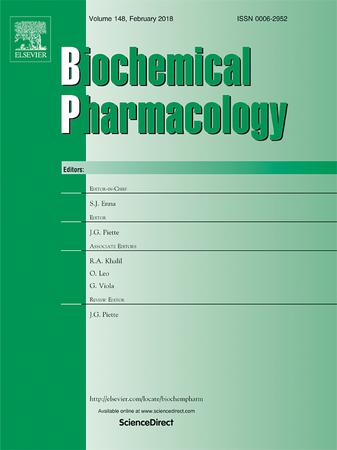Wnt信号通路中的治疗靶点:特异性治疗癌症
IF 5.3
2区 医学
Q1 PHARMACOLOGY & PHARMACY
引用次数: 0
摘要
Wnt信号通路是调控细胞周期进程、细胞凋亡、上皮-间质转化(EMT)、血管生成、干细胞和肿瘤免疫微环境的关键调控机制,同时也维持组织稳态。该通路的失调激活与多种癌症有关,与肿瘤的发生、发展和转移密切相关。Wnt/β-catenin轴在包括结直肠癌(CRC)、乳腺癌(BC)、肝癌和肺癌在内的常见癌症的发病机制中起核心作用。与传统的化疗不同,靶向治疗提供了一种更精确的癌症治疗方法。作为肿瘤发生的关键调节因子,Wnt通路代表了临床干预的一个有希望的目标。本文综述了Wnt信号通路的全面分析,探讨了其在肿瘤生物学中的作用及其在人类恶性肿瘤中的意义。它进一步研究了不同癌症的分子机制和作用模式,详细说明了Wnt途径如何通过促进转移、免疫调节、耐药和增强细胞增殖等机制促进肿瘤进展。最后,讨论了针对Wnt通路成分的治疗策略,包括针对细胞外成员以及细胞膜、细胞质和细胞核内成员的抑制剂。这些靶点在开发新型治疗药物方面的潜力强调了干预Wnt信号通路对有效治疗癌症的重要性。本文章由计算机程序翻译,如有差异,请以英文原文为准。

Therapeutic targets in the Wnt signaling pathway: Treating cancer with specificity
The Wnt signaling pathway is a critical regulatory mechanism that governs cell cycle progression, apoptosis, epithelial-mesenchymal transition (EMT), angiogenesis, stemness, and the tumor immune microenvironment, while also maintaining tissue homeostasis. Dysregulated activation of this pathway is implicated in various cancers, closely linked to tumor initiation, progression, and metastasis. The Wnt/β-catenin axis plays a central role in the pathogenesis of common cancers, including colorectal cancer (CRC), breast cancer (BC), liver cancer, and lung cancer. Unlike traditional chemotherapy, targeted therapy offers a more precise approach to cancer treatment. As a key regulator of oncogenesis, the Wnt pathway represents a promising target for clinical interventions. This review provides a comprehensive analysis of the Wnt signaling pathway, exploring its roles in tumor biology and its implications in human malignancies. It further examines the molecular mechanisms and modes of action across different cancers, detailing how the Wnt pathway contributes to tumor progression through mechanisms such as metastasis promotion, immune modulation, drug resistance, and enhanced cellular proliferation. Finally, therapeutic strategies targeting Wnt pathway components are discussed, including inhibitors targeting extracellular members, as well as those within the cell membrane, cytoplasm, and nucleus. The potential of these targets in the development of novel therapeutic agents underscores the critical importance of intervening in the Wnt signaling pathway for effective cancer treatment.
求助全文
通过发布文献求助,成功后即可免费获取论文全文。
去求助
来源期刊

Biochemical pharmacology
医学-药学
CiteScore
10.30
自引率
1.70%
发文量
420
审稿时长
17 days
期刊介绍:
Biochemical Pharmacology publishes original research findings, Commentaries and review articles related to the elucidation of cellular and tissue function(s) at the biochemical and molecular levels, the modification of cellular phenotype(s) by genetic, transcriptional/translational or drug/compound-induced modifications, as well as the pharmacodynamics and pharmacokinetics of xenobiotics and drugs, the latter including both small molecules and biologics.
The journal''s target audience includes scientists engaged in the identification and study of the mechanisms of action of xenobiotics, biologics and drugs and in the drug discovery and development process.
All areas of cellular biology and cellular, tissue/organ and whole animal pharmacology fall within the scope of the journal. Drug classes covered include anti-infectives, anti-inflammatory agents, chemotherapeutics, cardiovascular, endocrinological, immunological, metabolic, neurological and psychiatric drugs, as well as research on drug metabolism and kinetics. While medicinal chemistry is a topic of complimentary interest, manuscripts in this area must contain sufficient biological data to characterize pharmacologically the compounds reported. Submissions describing work focused predominately on chemical synthesis and molecular modeling will not be considered for review.
While particular emphasis is placed on reporting the results of molecular and biochemical studies, research involving the use of tissue and animal models of human pathophysiology and toxicology is of interest to the extent that it helps define drug mechanisms of action, safety and efficacy.
 求助内容:
求助内容: 应助结果提醒方式:
应助结果提醒方式:


